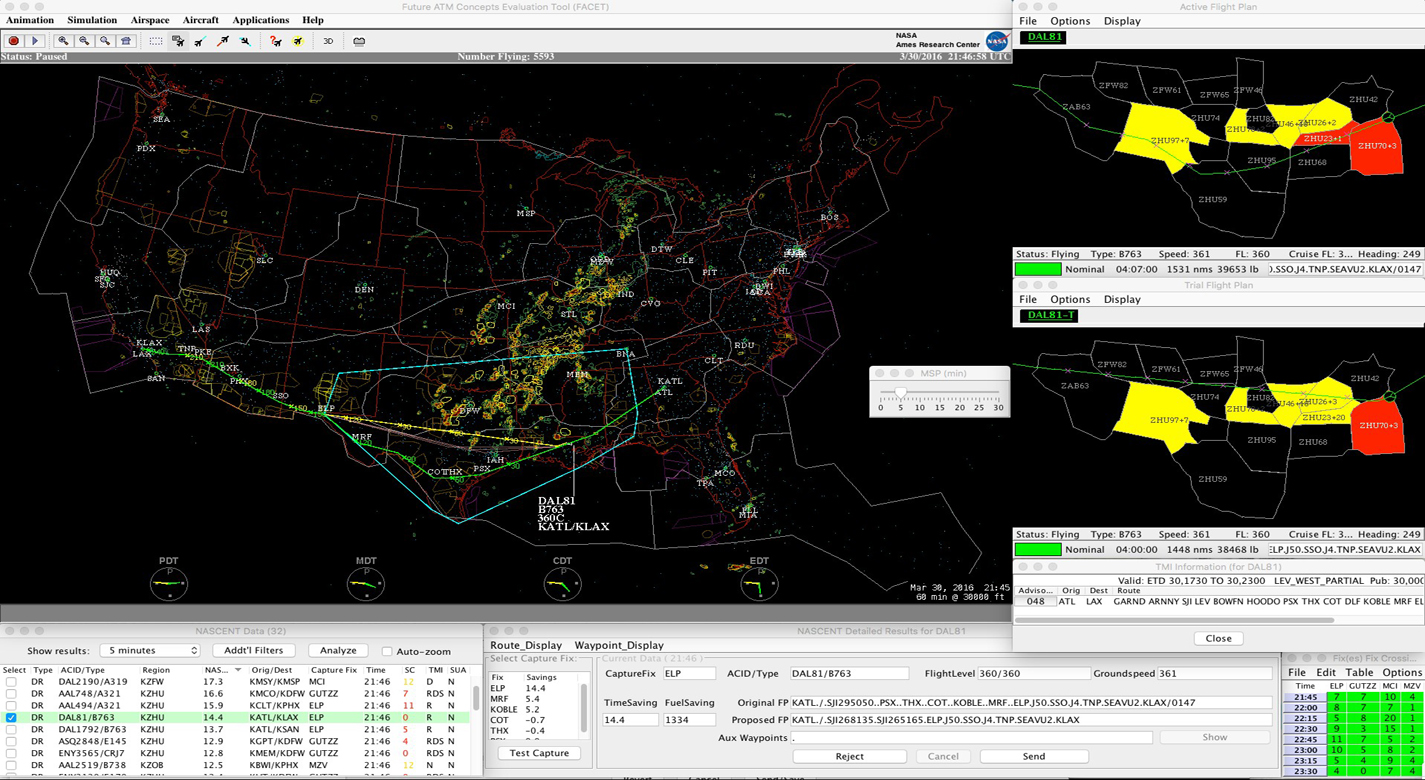Method and System for Air Traffic Rerouting for Air-space Constraint Resolution
aerospace
Method and System for Air Traffic Rerouting for Air-space Constraint Resolution (TOP2-258)
National Airspace System (NAS) Constraint Evaluation and Notification Tool (NASCENT)
Overview
NASA Ames Research Center's National Airspace System (NAS) Constraint Evaluation and Notification Tool (NASCENT) is a dynamic, ground-based, airspace constraint avoidance system that automatically analyzes routes of flying or predeparture aircraft, in or near constrained regions (due to weather, Special Use Airspace (SUA), etc.) It continuously analyzes time and fuel efficient reroutes around current and predicted constraints for thousands of flights in real-time. NASCENT provides an evaluation of operationally viable and historically implemented routes that save more than a user-specified number of minutes of wind-corrected flying time savings, for all the 20 Air Route Traffic Control Centers (ARTCCs or Centers) in the NAS, simultaneously. The system includes a flexible and intuitive graphical user interface that allows users to visualize, evaluate, modify (rubber-banding functionality), if necessary, and implement proposed reroutes (under current operational procedures).
The Technology
National Airspace System (NAS) Constraint Evaluation and Notification Tool (NASCENT) employs a NAS-wide simulation and analysis infrastructure that implements airspace constraint avoidance algorithms for efficient routing. NASCENT uses NASA-developed aircraft performance tables for computing climb, cruise, and descent trajectories. Reference routes are created that save more than a user-specified number (e.g., five) minutes of flying-time savings. The return capture fix for the reference route is the last fix on the current flight plan within a limit region (derived using this patented technology). A Maneuver Start Point is selected to allow time for coordination of the reroute with the Federal Aviation Administration (FAA). These routes are checked against the weather polygons, FAA denoted Special Use Airspaces (e.g., Military Operations Areas) and Temporary Flight Restrictions (TFRs); and additional waypoints are added to avoid these airspace constraints. The wind-corrected flying-time savings are reported for each flight. The polygons are first converted into convex hulls and inflated by a user-specified number of nautical miles (e.g., 20, for weather) to account for the FAA requirements. Lateral and/or vertical advisories are created using a binary tree search along the left-side and right-side, up to the return capture fix, to find a minimum-deviation delay solution. The NASCENT system provides notification for congested sectors along the current flight plan and the proposed avoidance route, along with flights impacted by FAA imposed required Traffic Management Initiatives (TMIs, reroutes, Ground Delay Programs, etc.). The reroutes can be implemented with no changes required to the current FAA operational infrastructure.

Benefits
- Simultaneously available in all 20 Centers
- Provides fuel savings and reduced delays
- Operationally viable and historically used route proposals
- Environmental emissions reduction
- Real-time handling of congestion, SUAs, TFRs, TMIs
- For airborne and pre-departure flights
- Air traffic data with one-minute updates
- Availability of Scheduled Times of Arrival at destination airport
- Agnostic of weather-model (FAA or Industry)
- NAS-wide simulation and analysis capability
Applications
- Aerospace industry
- Air Traffic Management
- Airline Dispatchers
- Airline Air Traffic Control Coordinators
Technology Details
aerospace
TOP2-258
ARC-17419-1
Sheth, K., McNally, D., Somersall, P., Morando, A., Clymer, A., and Shih, F., Assessment of a National Airspace System Airborne Rerouting Tool, 11th USA/Europe Air Traffic Management Research and Development Seminar, Lisbon, Portugal, June 2015.
Sheth, K., McNally, D., Morando, A., Clymer, A., Lock, J., Petersen, J., and Shih, F., Benefit Analysis of Multi-Center Dynamic Weather Routes, 14th AIAA Aviation Technology Integration and Operations Conference, Atlanta, GA, June 2014.
Sheth, K., McNally, D., Morando, A., Clymer, A., Lock, J., Petersen, J., and Shih, F., Benefit Analysis of Multi-Center Dynamic Weather Routes, 14th AIAA Aviation Technology Integration and Operations Conference, Atlanta, GA, June 2014.
Similar Results

Traffic Aware Strategic Aircrew Requests (TASAR)
The NASA software application developed under the TASAR project is called the Traffic Aware Planner (TAP). TAP automatically monitors for flight optimization opportunities in the form of lateral and/or vertical trajectory changes. Surveillance data of nearby aircraft, using ADS-B IN technology, are processed to evaluate and avoid possible conflicts resulting from requested changes in the trajectory. TAP also leverages real-time connectivity to external information sources, if available, of operational data relating to winds, weather, restricted airspace, etc., to produce the most acceptable and beneficial trajectory-change solutions available at the time. The software application is designed for installation on low-cost Electronic Flight Bags that provide read-only access to avionics data. The user interface is also compatible with the popular iPad. FAA certification and operational approval requirements are expected to be minimal for this non-safety-critical flight-efficiency application, reducing implementation cost and accelerating adoption by the airspace user community.
Awarded "2016 NASA Software of the Year"

Unmanned Aerial Systems (UAS) Traffic Management
NASA Ames has developed an Autonomous Situational Awareness Platform system for a UAS (ASAP-U), a traffic management system to incorporate Unmanned Aerial Systems (UASs) into the National Airspace System. The Autonomous Situational Awareness Platform (ASAP) is a system that combines existing navigation technology (both aviation and maritime) with new procedures to safely integrate Unmanned Aerial Systems (UASs) with other airspace vehicles. It uses a module called ASAP-U, which includes a transmitter, receivers, and various links to other UAS systems. The module collects global positioning system GPS coordinates and time from a satellite antenna, and this data is fed to the UAS's flight management system for navigation. The ASAP-U module autonomously and continuously sends UAS information via a radio frequency (RF) antenna using Self-Organized Time Division Multiple Access (SOTDMA) to prevent signal overlap. It also receives ASAP data from other aircraft. In case of transmission overload, priority is given to closer aircraft. Additionally, the module can receive weather data, navigational aid data, terrain data, and updates to the UAS flight plan. The collected data is relayed to the flight management system, which includes various databases and a navigation computer to calculate necessary flight plan modifications based on regulations, right-of-way rules, terrain, and geofencing. Conflicts are checked against databases, and if none are found, the flight plan is implemented. If conflicts arise, modifications can be made. The ASAP-U module continuously receives and transmits data, including UAS data and data from other aircraft, to detect conflicts with other aircraft, terrain, weather, and geofencing. Based on this information, the flight management system determines the need for course adjustments and the flight control system executes them for a safe flight route.

Digital Twin Simulator of the National Airspace System (NAS)
The digital twin NAS simulator provides a complete digital copy of the individual systems that comprise the NAS to allow for the creation of offline simulations to test proposed changes to one or more individual systems based on actual historical data from the NAS or on real-time data from the NAS. The NAS is composed of a collection of systems, including source systems such as weather stations from various locations or airports, which are used by other systems such as individual aircraft flight data and airline operators. Other systems may include management systems such as the FAA, air traffic control centers, and flight traffic monitors. Operational data from each of these systems may be archived by a central information sharing platform such as the System Wide Information Management (SWIM) Program operated by the FAA. The digital twin NAS simulator can access archived SWIM data to create a digital twin NAS system to provide a virtual environment that may operate in real-time alongside the actual NAS, with the digital twin receiving live data updates from the actual NAS. A dedicated application programming interface (API) is used to facilitate communication between various distributed external components and the testbed. The testbed receives NAS data during a test and feeds the data to the simulation manager for use with a digital twin of the NAS system. The result is a virtual environment that is an exact twin of the actual operational system and is able to function identically to the actual NAS system because it is based on and uses the same data archived from the actual NAS system. A primary function of the virtual twin NAS is that it will allow for changes to one or more systems to be simulated against the archived NAS data and subsequently allow for a comparison between the simulated results and the actual results from the operational system. The digital twin simulator may also function in a distributed network environment, allowing for simulations of different elements to run simultaneously, which speeds up and improves the testing and evaluation of proposed changes.

FACET: Future Air Traffic Management Concepts Evaluation Tool
Actual air traffic data and weather information are utilized to evaluate an aircrafts flight-plan route and predict its trajectories for the climb, cruise, and descent phases. The dynamics for heading (the direction the aircraft nose is pointing) and airspeed are also modeled by the FACET software, while performance parameters, such as climb/descent rates and speeds and cruise speeds, can also be obtained from data tables. The resulting trajectories and traffic flow data are presented in a 3-D graphical user interface. The FACET software is modular and is written in the Java and C programming languages. Notable FACET applications include reroute conformance monitoring algorithms that have been implemented in one of the Federal Aviation Administrations nationally deployed, real-time operational systems.

Mitigating Risk in Commercial Aviation Operations
NASA’s newly developed software leverages flight operations data (e.g., SWIM Terminal Data Distribution System (STDDS) information), and with it, can predict aviation related risks, such as unstable approaches of flights. To do this, the software inputs the complex, multi-source STDDS data, and outputs novel prediction and outcome information.
The software converts the relatively inaccessible SWIM data from its native format that is not data science friendly into a format easily readable by most programs. The converted, model friendly data are then input into machine learning algorithms to enable risk prediction capabilities. The backend software sends the machine learning algorithm results to the front end software to display the results in appropriate user interfaces. These user interfaces can be deployed on different platforms including mobile phones and desktop computers and efficiently update models based on changes in the data.
To allow for visualization, the software uses a commercially available mapping API. The data are visualized in several different ways, including a heat map layer that shows the risk score, with higher risk in areas of higher flight density, a polyline layer, which shows flight paths, and markers that can indicate a flight’s location in real time, among other things. The related patent is now available to license. Please note that NASA does not manufacturer products itself for commercial sale.



